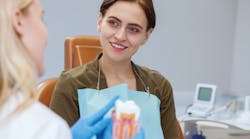One advantage of practicing dental hygiene as long as I have is that I recall what weight professional recommendations held with patient interactions in the 1980s and ’90s. For the most part, if I advised patients to have a topical fluoride treatment or switch to a power toothbrush, they were easily persuaded by the facts presented to them from the “expert.” Traditionally, health-care professionals (physicians, dentists, dental hygienists, etc.) have enjoyed being deferred to as the experts patients value and trust. But an unmistakable shift has taken place, and as a result, wise health-care professionals will take necessary measures to gain and maintain the trust of patients. Today, patients are likely to value or trust social media recommendations, health and lifestyle blogs, and friends’ recommendations as much, if not more, than “expert” advice. Likewise, patients often use no discrimination regarding whether the sources of recommendations and information are evidence-based.
Let’s take professional topical fluoride treatments for example. If you question the safety of professional fluoride treatments using a Google search, it generates more than 3,200,000 options with both evidence-based guidance and misinformation mingled together. If you type “fluoride safety” into a Facebook search, evidence-based information and misinformation again are integrated. Patients have easy, 24-hour access to information to formulate their own opinions. Due to the fact that trust in health-care professionals in general has diminished,1 professional recommendations do not hold the same weight they once did, and sometimes health-care professionals’ advice is even viewed as suspicious or self-serving. I recall an incident recently when a patient accused me of being “too slick” as I communicated his need for nonsurgical treatment based on solid evidence—aka, the facts.
A recent article published in the New England Journal of Medicine (NEJM) titled, “Mistrust in Science—A Threat to the Patient-Physician Relationship”2 piqued my interest, so I want to share a summary of what I learned and strategies that are applicable to our patient-dentist and patient–dental hygienist relationships.
In 1927, Dr. Francis Weld Peabody published an editorial in the Journal of the American Medical Association that is more relevant today than ever before. He stated, “The secret of the care of the patient is in caring for the patient.”3 Relationships build trust, and while that was important almost a century ago, it is even more critical today since the facts or science themselves aren’t always the deciding factors in patients’ decision-making. A sobering statistic referenced in the recent NEJM article gives some perspective on the trust issue with patients and health-care providers.
According to the think tank Aspen Institute, an extensive survey reveals that confidence in almost all major institutions, including media and government, has dropped substantially.1 But surprisingly, the greatest decline occurred in the US medical system, which fell dramatically from 80% in 1975 to 37% in 2015.1 While this may not correlate 100% to patient confidence with dental professionals, we are wise to recognize trust is not a given just because we are well informed in evidence-based science. We need strategies to secure patient trust.
The following are suggestions to discuss at your next team meeting to help refine your own efforts at gaining and maintaining patient trust:
Personal information—Seek personal information that elucidates what is most valuable to the patient. On new-patient registration forms, be sure to solicit information unique to each patient. Ask for input about prior dental experiences (favorable and unfavorable). Inquire about their dental goals (optimal function, esthetics, economical options, time-saving strategies for treatment, comfort, pain management, etc.). During the interview process, give patients an opportunity to elaborate on their personal goals and concerns. Become an expert listener, and record patient preferences so that the information does not have to be repeated to each provider. Designate a place in the patient record for personal information and preferences, and review that information prior to visits to help you value what’s most important to each patient. Being personal with patients can build trust.
Social sharing—Ask your patients to provide reviews on social media outlets specific to positive outcomes. For example, when patients have optimal outcomes with their esthetic treatment, make it easy for them to write a review by providing the link and requesting they do so before they leave the office. Don’t assume patients will take time to do this on their own. Be proactive in asking for their input. Positive reviews influence decision-making today, and the greater the number of positive reviews, the greater the likelihood new patients will be willing to trust you with their care.
Photos—Take pictures of each patient and store them in their charts. During chart reviews in the morning prior to seeing patients, if you are not able to put the name with the face, click on the patient picture so you are prepared to call the patient by name when greeting them in the hallway or treatment room. Using the patient’s name during treatment and office visits increases comfort and trust.
Advocate—Speak positively about other team members the patient will interact with. Emphasize their competence and your trust in them. The NEJM article previously referenced described an example of how one emergency department among numerous hospitals stood out from others based on patient satisfaction surveys. It turned out that this particular emergency department was in the habit of acknowledging the role and competency of other members of the team to the patients prior to a handoff.2 Your trust and confidence in other team members influences patient trust in them as well.
We need to stay abreast of the science so we can communicate facts and help dispel misinformation. That alone, however, will not be enough to gain and maintain patient trust now and in the future. We need to implement strategies that build relationships beyond facts, beyond science, and beyond hearsay. We need relationships that are unique and personal to what matters most to each individual’s preferences and needs. This may sound simple enough, but it requires deliberate implementation in order to garner those results.
References
1. Aspen Institute. Crisis in democracy: renewing trust in America—the report of the Knight Commission on trust, media and democracy. Available at: http://csreports.aspeninstitute.org/document/Knight2019.pdf. Published 2019.
2. Baron RJ, Berinsky AJ. Mistrust in science—a threat to the patient-physician relationship. New Engl J Med. 2019;381(2):182-185.
3. Peabody FW. The care of the patient. J Am Med Assoc. 1927;88(12):877-882.
Karen Davis, BSDH, RDH, is the founder of Cutting Edge Concepts, an international continuing education company. She practices dental hygiene in Dallas, Texas. She is an independent consultant to the Philips Corporation, Periosciences, and Hu-Friedy/EMS. She can be reached at [email protected].







